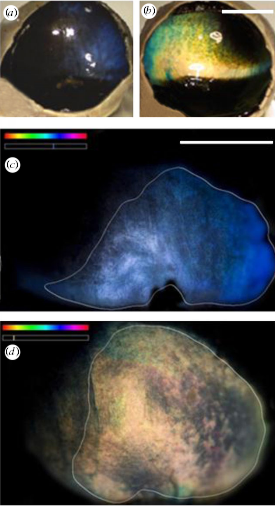Reindeer Eyes Change Color From Gold To Blue Depending On Arctic Seasons [PHOTO]

Arctic reindeer have a colorful way of seeing the world.
Researchers have discovered that Arctic reindeer eyes change color as the seasons change, from gold in the summer to blue in the winter. The findings, published in Proceedings of the Royal Society B, reveal how the animals adapt to extreme changes in daylight that help them detect predators.
"No one has ever seen anything like this in a mammal before, let alone such a large shift," Neuroscientist Glen Jeffery, who investigates vision at University College London, told LiveScience.
Researchers found that the color change helped reindeers see better in the continuous daylight of summer and darkness of Arctic winters. The color change represents a changing of sensitivity of the reindeer’s retinas to light. In particular, a specific tissue later called the tapetum lucidum (TL), located behind the retina to reflect light back to enhance night vision.
During the winter, reindeer eyes increase pressure inside the eyeball to compress the tapetum lucidum to reflect bluer light. In the summer, the eyes turn gold to allow most light to reflect through the retina.
"We have some evidence that the blue reflection in winter amplifies ultraviolet light, while in summer it suppresses it," Jeffery said.
Scientists made the discovery after collecting reindeer eyes over a period of 12 years. Some came from reindeer killed in the summer, others in the winter. The color change is most likely to help the mammals detect predators and forage for food.
“By changing the color of the TL in the eye reindeer have flexibility to cope better with the extreme differences between light levels in their habitat between seasons, “Jeffrey said in a statement. “This gives them an advantage when it comes to spotting predators, which could save their lives."
Some scientists provide a different explanation for the color change.
“I wouldn’t be at all surprised if the retina managed to increase its sensitivity during winter through some kind of intra-retinal changes, quite separate from the tapetal ones,” Trevor Lamb, an eye expert at the Australian National University not involved in the study, told National Geographic adding that his theory was pure speculation.
Dan-Eric Nilsson, a vision expert from Lund University, agrees. “They’ve found an interesting phenomenon, but failed in explaining it,” he said adding that the reindeer might be experiencing changing levels of light-sensitive pigments in their retinas.
© Copyright IBTimes 2025. All rights reserved.




















